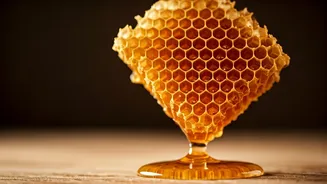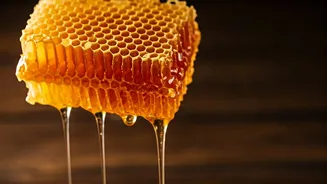The Thumb Test
This is a quick and accessible method to initially assess honey quality. Place a small drop of honey on your thumb and observe how it behaves. Pure honey should
be thick and remain intact, slowly flowing downwards. If the honey spreads quickly or feels watery, it might be mixed with sugar syrup or other additives. This test provides an immediate visual clue, helping you distinguish between authentic and potentially compromised honey. The slow, cohesive flow is a good sign.
The Vinegar Test
A clever technique to detect potential adulteration involves combining honey with vinegar and water. Mix a teaspoon of honey with a small amount of water, then add a few drops of vinegar. If the honey is pure, no reaction will occur. However, if the mixture begins to foam or bubble, it could indicate the presence of additives such as chalk powder or other substances used to thicken the honey. This test offers a simple way to uncover unwanted ingredients that may be present in your honey.
The Water Test
Another straightforward test to gauge the purity of your honey involves a glass of water. Pour a spoonful of honey into a glass of water and observe how it settles. Genuine honey is dense and will sink to the bottom without dissolving immediately. It should remain as a cohesive mass. If the honey dissolves readily or begins to mix with the water, it may contain added sugar or other sweeteners. This simple water test can provide a quick visual cue regarding the honey's composition.
Crystallization Check
Observing the honey's crystallization pattern is another way to assess its authenticity. Over time, pure honey tends to crystallize, which is a natural process. This crystallization can vary in texture, from fine grains to larger crystals. While crystallization itself doesn't automatically mean the honey is impure, the presence of unusual crystals or a failure to crystallize at all could indicate adulteration. Examine the texture and consistency to better understand your honey’s nature.
The Flame Test
The flame test provides another quick method to check for honey purity. Dip a dry wick or a cotton swab into the honey and then try to light it. Pure honey, with its high sugar content, is flammable. If the honey is pure, the wick should ignite and burn readily. If the honey contains added water or other adulterants, the wick won't light easily, or it might struggle to sustain a flame. This test provides a simple and somewhat dramatic indication of the honey's flammability.
Check the Label
Always read the label carefully for vital clues about your honey. Look for phrases that indicate the honey is 100% pure and unprocessed. Verify the country of origin, as honey from some regions may have a higher risk of adulteration. Examine the ingredient list; pure honey should only contain honey. If any other ingredients are listed, the honey is not pure. Additionally, verify the manufacturer's details and any certifications that could guarantee quality.
Laboratory Testing
For the most accurate assessment of honey purity, consider laboratory testing. Professional analysis can detect a variety of adulterants that are difficult to identify with home tests. These tests can measure the honey's composition, including its sugar content, and identify the presence of any additives. While more expensive than other methods, laboratory testing offers definitive results and can detect even minor impurities, ensuring the highest level of confidence in your honey’s authenticity.









